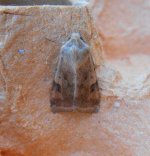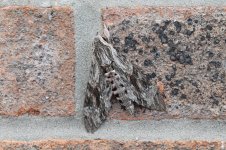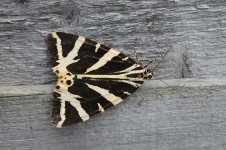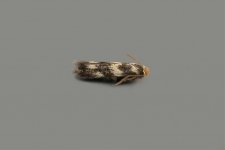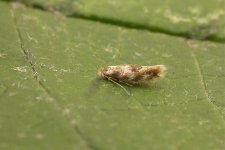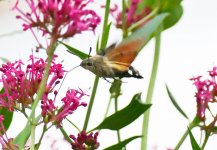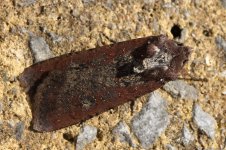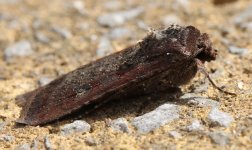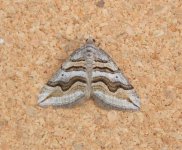-
Welcome to BirdForum, the internet's largest birding community with thousands of members from all over the world. The forums are dedicated to wild birds, birding, binoculars and equipment and all that goes with it.
Please register for an account to take part in the discussions in the forum, post your pictures in the gallery and more.
You are using an out of date browser. It may not display this or other websites correctly.
You should upgrade or use an alternative browser.
You should upgrade or use an alternative browser.
September Moths (1 Viewer)
- Thread starter smokenack
- Start date
More options
Who Replied?Paul Chapman
Well-known member
Wednesday morning produced the second patch macro tick of the year with a Convolvulus Hawkmoth to a friend's garden trap. Again, one of the commonest macros that we had not yet recorded on the patch with 17 records between 1990 and 2006 in the local atlas. Obvious gaps getting fewer. I must refresh the patch list at some point. A picture attached of that and August's second Jersey Tiger.
Edit - a quick check suggests that it was my 444th patch macro. Eleven new macros in the last three years - five in 2013 (Waved Carpet, Bordered Pug, Four-spotted Footman, Mallow & Delicate); four in 2014 (Northern Spinach, Horse Chestnut, Grey Chi & Blair's Mocha); & two in 2015 (Ruddy Carpet & Convolvulus Hawkmoth).
Any smugness was however wiped off our faces by a friend's Clifden Nonpareil on a short trip back to the south west. Well established in Dorset - perhaps it is spreading?
All the best
Paul
Edit - a quick check suggests that it was my 444th patch macro. Eleven new macros in the last three years - five in 2013 (Waved Carpet, Bordered Pug, Four-spotted Footman, Mallow & Delicate); four in 2014 (Northern Spinach, Horse Chestnut, Grey Chi & Blair's Mocha); & two in 2015 (Ruddy Carpet & Convolvulus Hawkmoth).
Any smugness was however wiped off our faces by a friend's Clifden Nonpareil on a short trip back to the south west. Well established in Dorset - perhaps it is spreading?
All the best
Paul
Attachments
Last edited:
What a stunning Convolvulus Hawkmoth, but what also caught My eye has with a number of moths I have seen on this forum is how they Find the Identical background to rest on which matches their colour and Markings perfectly stunning camouflage at times as shown hereWednesday morning produced the second patch macro tick of the year with a Convolvulus Hawkmoth to a friend's garden trap. Again, one of the commonest macros that we had not yet recorded on the patch with 17 records between 1990 and 2006 in the local atlas. Obvious gaps getting fewer. I must refresh the patch list at some point. A picture attached of that and August's second Jersey Tiger.
Any smugness was however wiped off our faces by a friend's Clifden Nonpareil on a short trip back to the south west. Well established in Dorset - perhaps it is spreading?
All the best
Paul
Coal Tit.
Andy Atkinson
Druridge Bayer
Norway-maple Pigmy
Hi all
After a couple of seasons of serious moth trapping had my first county first the other night - Norway-maple Pigmy (Ectoedemia sericopeza) confirmed as a male by gen det by the county recorder.
Trapped at Gosforth Park Nature Reserve in Newcastle upon Tyne (shame it wasn't my back garden).
The nearest confirmed UK sighting of this moth is in Lancashire and there's only been 20 or so in the whole of the UK by the looks of it. Very pleased!
Also caught Bucculatrix ulmella in the same session - only the second adult to be found in the county of Northumberland, my first Old Lady (Mormo maura) and Argyresthia spinosella (9th county record).
What a night.
Andy
Images: courtesy of Tom Tams
Hi all
After a couple of seasons of serious moth trapping had my first county first the other night - Norway-maple Pigmy (Ectoedemia sericopeza) confirmed as a male by gen det by the county recorder.
Trapped at Gosforth Park Nature Reserve in Newcastle upon Tyne (shame it wasn't my back garden).
The nearest confirmed UK sighting of this moth is in Lancashire and there's only been 20 or so in the whole of the UK by the looks of it. Very pleased!
Also caught Bucculatrix ulmella in the same session - only the second adult to be found in the county of Northumberland, my first Old Lady (Mormo maura) and Argyresthia spinosella (9th county record).
What a night.
Andy
Images: courtesy of Tom Tams
Attachments
Normal September fayre at the moment, most nights c.70 moths of c.20 species. Surprise last night was a Plumed Fan-foot. I had a spate of records in July so I suppose this is a 2nd brood. Might be a colony nearby apart from the East London one. Smaller than the July moths as well, forewing length 12mm.
MSA
I may be relaxed but I'm not drunk....
It's all been a bit "samey" recently, Large Yellow Underwings dominating (in record numbers for my short mothing "career" - 30+ some nights), so Thursday night was a surprise, a lifer (Parsnip Moth - Depressaria radiella), a garden tick (Argyresthia goedartella) and two year-ticks (Lesser Swallow Prominent and Lunar Underwing) amongst 52 moths of 18 sp.
Paul Chapman
Well-known member
Similar for me - Large Yellow Underwings, Lesser Yellow Underwings and Square-spot Rustics being the majority of numbers - the odd Thorn and second brood moth such as Light Emerald etc - but a Pearly Underwing this morning hid amongst the Large Yellow Underwings giving itself away by its thoracic crest.
A friend had an L-album Wainscot last night which is a recent colonist for us.
All the best
Paul
A friend had an L-album Wainscot last night which is a recent colonist for us.
All the best
Paul
Attachments
Tiraya
San Diego CA

I keep hearing people reference this thing called "A Label and Checklist of the British Micro-lepidoptera with Vernacular Names, Jim Porter 2002" but I've never found any evidence this actually exists online or in real life. And there is apparently a revision in 2009 but I'll settle with either. What secret lab is it kept in :t:?
Some of the names I see pulled out of it seems a bit silly and won't replace my vernacular names I already use (for instance "long-horn flat-body" for Carcina quercana, I preferred "oak lantern"), but I'd like to see it nonetheless.
Some of the names I see pulled out of it seems a bit silly and won't replace my vernacular names I already use (for instance "long-horn flat-body" for Carcina quercana, I preferred "oak lantern"), but I'd like to see it nonetheless.
Last edited:
Paul Chapman
Well-known member
Forty species in the garden MV last night, the highlight being this rather lovely Spanish Carpet.
Very very gripped. A chance at another British one after the demise of the Studland population would be well-received!
I keep hearing people reference this thing called "A Label and Checklist of the British Micro-lepidoptera with Vernacular Names, Jim Porter 2002" but I've never found any evidence this actually exists online or in real life. And there is apparently a revision in 2009 but I'll settle with either. What secret lab is it kept in :t:?
Some of the names I see pulled out of it seems a bit silly and won't replace my vernacular names I already use (for instance "long-horn flat-body" for Carcina quercana, I preferred "oak lantern"), but I'd like to see it nonetheless.
I found the NHM link below on an Internet search but I've never struggled with the name of Carcina quercana - very common in the right habitat at the right time of year - and I cannot imagine being tempted to call it anything else!
http://www.nhm.ac.uk/research-curat...pecies/checklists/NHMSYS0020503323/index.html
http://skevsblog.blogspot.co.uk/2012/02/vulgar-vernaculars.html
All the best
Last edited:
Tiraya
San Diego CA

I found this on an Internet search but I've never struggled with Carcina quercana - very common in the right habitat at the right time of year. I've never called it anything else or wanted to do so!
http://www.nhm.ac.uk/research-curat...pecies/checklists/NHMSYS0020503323/index.html
http://skevsblog.blogspot.co.uk/2012/02/vulgar-vernaculars.html
All the best
I agree, its one of those moths I'm so used to referring by its scientific name I don't think I could make myself change that. But I still preferred oak lantern over long-horned flat-body even if I never use either :t:
Yep I found those links while searching as well. I guess I assumed it was some kind of actual academic publication of sorts and that there was a .pdf to look at.
honeym
Well-known member
There are various versions of the British list with vernacular names. Jim's is perhaps the most recent. Probably because the microlepdoptera were a 'serious' hobby, requiring special study, most microlepidopterist's just don't use them.
Perhaps the most famous (or infamous) would be Ian Robert Penicuik Heslop's Revised indexed check-list of the British Lepidoptera : with the English name of each of the 2,404 species. There's also one that I like just because of the author's name: Beowolf A. Cooper's A new system of English naming for British macrolepidoptera.
There's a piece on micro vernacular names here (http://www.norfolkmoths.co.uk/micro_names.php), which gives the Introduction from Jim's book.
Martin
Perhaps the most famous (or infamous) would be Ian Robert Penicuik Heslop's Revised indexed check-list of the British Lepidoptera : with the English name of each of the 2,404 species. There's also one that I like just because of the author's name: Beowolf A. Cooper's A new system of English naming for British macrolepidoptera.
There's a piece on micro vernacular names here (http://www.norfolkmoths.co.uk/micro_names.php), which gives the Introduction from Jim's book.
Martin
Last edited:
DMW
Well-known member
Very very gripped. A chance at another British one after the demise of the Studland population would be well-received!
Spanish Carpet is described as locally common in Jersey. This is the first one I've trapped, but perhaps not surprising as I'm not aware of the food plant growing near to my garden. Being perhaps a little mischievous, Studland does appear to be mighty close to passing ferries en route from the Channel Islands!
Cheers
Duncan
MSA
I may be relaxed but I'm not drunk....
Hi Mark
That must be quite a good record, looking at the Hants moths website maps, and an end-of-season record.
Martin
You inspired me to look at the map, Martin, and from that it does look to be a good record! However, the "blurb" suggests it's relatively common, so I'm guessing it's more a case of under-recorded? As to flight seasons, I'm never sure how strictly they should be taken, as I'd expect weather to have a significant impact.
Users who are viewing this thread
Total: 2 (members: 0, guests: 2)




